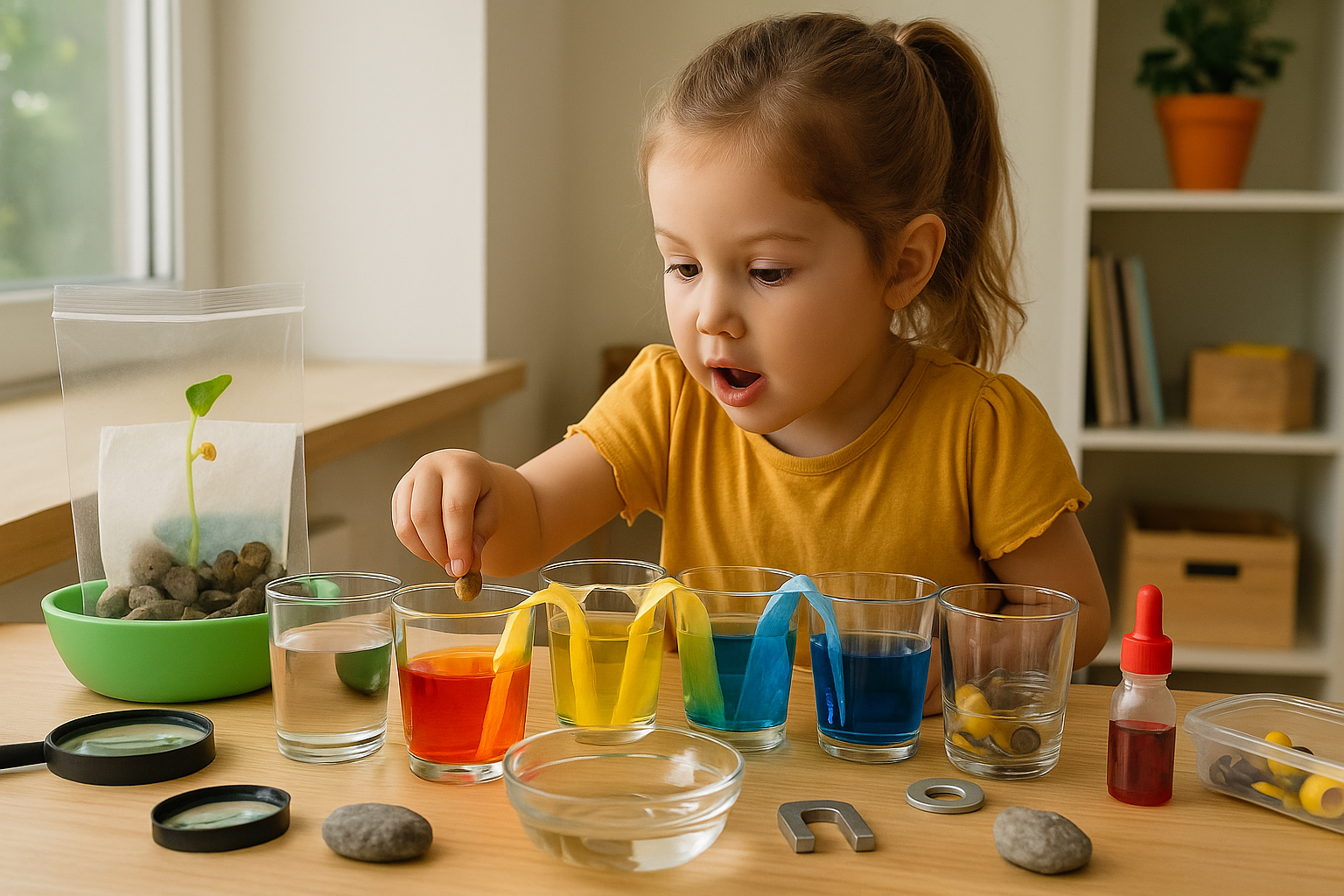Young children are naturally curious about how the world works—and science is the perfect way to nurture that curiosity. You don’t need a lab coat or fancy equipment to explore scientific thinking. With just a few materials from around the house, you can introduce preschoolers to concepts like observation, prediction, and cause and effect in fun and engaging ways.
This article will show you how to set up 10 simple science activities at home to spark your child’s imagination and love for discovery.
Why Science in Early Childhood Matters
Introducing science early helps children:
- Ask questions and explore answers
- Learn through trial and error
- Develop observation and reasoning skills
- Expand vocabulary related to nature and phenomena
- Build confidence in problem-solving
Science in early childhood is less about memorizing facts and more about developing a way of thinking—and having fun doing it.
1. Sink or Float Experiment
Fill a large bowl or tub with water and gather a mix of objects (toy, spoon, crayon, leaf, coin, sponge).
Ask:
- “What do you think will happen?”
- “Will it sink or float?”
Let your child test each item and sort them into two groups. You can also chart the results for added learning.
Skills developed: hypothesis-making, observation, sorting
2. Baking Soda and Vinegar Reactions
Place a few spoonfuls of baking soda in a tray. Use a dropper to add vinegar and watch the fizzy reaction.
Try variations:
- Add food coloring
- Hide small toys in the baking soda for a “volcano dig”
- Use muffin tins for a rainbow effect
Skills developed: cause and effect, sensory exploration
3. Ice Melting Race
Freeze small toys in cups or bowls of water. Challenge your child to find ways to melt the ice faster.
Materials to try:
- Salt
- Warm water
- Spoons
- A hairdryer (with supervision)
Ask:
- “Which one worked fastest?”
- “Why do you think that happened?”
Skills developed: experimentation, time awareness, comparison
4. Nature Walk and Observation
Take a walk outside and bring a small bag or basket for collecting interesting items like leaves, rocks, feathers, or flowers.
Back at home:
- Sort by color or size
- Use a magnifying glass
- Create a nature collage or sensory tray
Skills developed: environmental awareness, classification, attention to detail
5. Rainbow Walking Water
Place six cups in a row: fill three with water dyed red, yellow, and blue. Leave the others empty. Connect them with folded paper towels.
Over several hours, the colored water “walks” to the empty cups and mixes to form new colors.
Skills developed: color theory, absorption, patience
6. Magnetic vs. Non-Magnetic Sort
Use a child-safe magnet and test various household items like keys, paperclips, coins, plastic utensils, buttons, and fabric.
Ask:
- “What do you think will stick?”
- “Why do some things attract the magnet?”
Sort the objects and draw conclusions.
Skills developed: observation, sorting, classification
7. Shadow Play
Shine a flashlight on toys or your child’s hand to create shadows on the wall.
Try:
- Making shadow puppets
- Observing how shadows change shape with distance
- Drawing around shadows on paper
Go outside during the day and observe how shadows move with the sun.
Skills developed: light and space understanding, creativity, observation
8. Growing Seeds in a Bag
Place a damp paper towel inside a clear plastic bag. Insert a bean seed and tape the bag to a window with sunlight.
Watch over several days:
- Sprouting
- Root development
- Stem growth
Extension: Keep a seed observation journal with drawings or photos.
Skills developed: biology basics, patience, sequencing
9. Homemade Slime or Oobleck
For slime:
- Mix glue, baking soda, and a bit of saline solution.
For oobleck:
- Mix cornstarch and water (2:1 ratio). It’s solid when squeezed and liquid when released.
These textures are fascinating and open the door to talking about states of matter.
Skills developed: sensory exploration, early chemistry
10. DIY Weather Station
Track daily weather by creating a simple weather board:
- Sunny, rainy, cloudy, windy
- Thermometer (real or pretend)
- Add symbols with Velcro or magnets
Ask:
- “What’s the weather today?”
- “How did it change from yesterday?”
- “What clothes should we wear?”
Skills developed: weather observation, pattern recognition, responsibility
Science Starts with a Question
Every science activity begins with curiosity—“What happens if…?” When you encourage that mindset at home, you help your child become a lifelong learner who observes, explores, and thinks critically.
Remember:
- Don’t worry about “teaching” the correct answer
- Focus on exploration and discovery
- Let your child lead and ask questions
- Celebrate the process more than the outcome
With just a few materials and a curious spirit, you can turn your home into a place of wonder and discovery.
